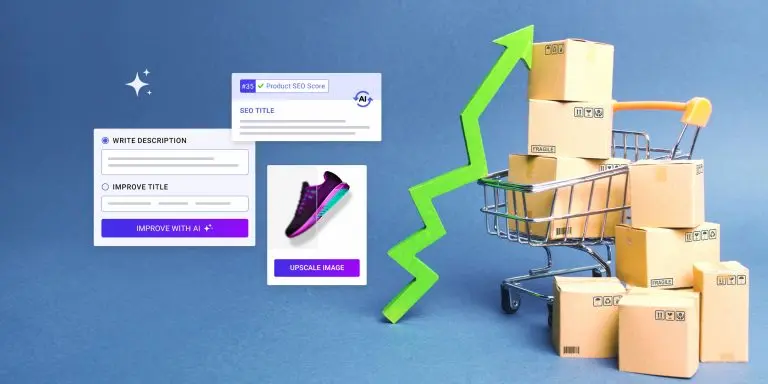We’ve previously written about dropshipping as a side hustle, so naturally, the next question we want to take on is: Can dropshipping become a full-time job?
The answer? Yes, absolutely, but it’s not as simple as it may sound. While the idea of running a hands-off business and making money while you sleep is appealing, building a successful dropshipping business that can replace a full-time income requires strategy, commitment, and a lot of hard work.
So, in this article, we’ll explore the possibilities of turning dropshipping into a full-time job, the challenges involved, and how you can make it happen.
Table of Contents
What is dropshipping?
Before diving into whether dropshipping can be a full-time job, let’s briefly recap what dropshipping is. Dropshipping is an ecommerce business model where you sell products without holding inventory. When a customer places an order on your store, you purchase the product from a third-party supplier, who then ships it directly to the customer.
You act as the middleman, handling the storefront and marketing, while your supplier manages the logistics. This model allows you to focus on growing your business without worrying about stocking products, warehousing, or shipping.
The potential of dropshipping
Dropshipping is part of the ecommerce industry, which is experiencing explosive growth year after year, making it a profitable option for entrepreneurs looking to scale their businesses.
The global dropshipping market is expected to reach $201 billion in 2024 and skyrocket to $1,253 billion by 2030 according to this report by Grand View Research. And, Statista, forecasts that the global dropshipping market may hit $301 billion in 2024 and will continue to expand, reaching $476.1 billion by 2026. These numbers reflect how massive this industry is becoming and the opportunities it holds for both new and established entrepreneurs.
Additionally, the overall global B2C ecommerce market is also projected to reach a staggering $17,770.52 billion by 2030, showcasing the immense growth of online retail. (Source)
As ecommerce continues to expand, dropshipping remains a vital part of this growth. With the right approach and strategy, dropshipping offers entrepreneurs an opportunity to tap into a billion-dollar industry, making it a highly viable option as a full-time business.
Read more: The Million-Dollar Question: Can Dropshipping Make You Rich
Can dropshipping be a full-time job?
Yes, dropshipping can absolutely be turned into a full-time job. In fact, many successful entrepreneurs have built thriving dropshipping businesses that generate six or even seven-figure incomes. However, this doesn’t happen overnight. Dropshipping, like any business, requires dedication, time, and the right strategies to scale into a full-time operation.
So, how can you transition from a side hustle to a full-time dropshipping career? Read on to find out.
Steps to make dropshipping a full-time career
1. Start small and scale up
One of the benefits of dropshipping is that you can start small with minimal upfront investment. It’s a great way to test the waters and build experience without risking a significant amount of money. However, if your goal is to turn dropshipping into a full-time job, you’ll need to focus on scaling your business.
Start by testing different products and niches to find what works. Once you’ve identified profitable products, invest more time and resources into scaling your store. This may involve increasing your marketing budget, improving your website’s user experience, and expanding your product range.
Scaling up is essential if you want to generate a consistent income from dropshipping. You’ll need to move beyond relying on a few products and find ways to automate your processes to handle higher volumes of sales efficiently.
2. Choose the right niche
One of the keys to success in dropshipping is choosing the right niche. While it may be tempting to sell anything and everything, successful dropshipping businesses often focus on a specific niche. Why? Targeting a specific audience allows you to tailor your marketing efforts, build brand loyalty, and stand out from the competition.
Look for niches that have high demand but aren’t oversaturated with competition. You want to find a balance between a niche that’s popular enough to generate sales but not so crowded that it’s hard to break through the noise.
Consider niches with passionate communities, as these customers are more likely to engage with your brand and make repeat purchases. Some examples of niche markets include electronics & gadgets, pet accessories, or fitness and outdoor gear.
Watch our video below where we explore why being niche-specific is crucial for building a profitable and sustainable dropshipping business.
3. Master your marketing
Marketing is the backbone of any successful dropshipping business. Since you don’t manufacture or store the products yourself, your success depends on how well you can drive traffic to your store and convert visitors into buyers. Without strong marketing strategies, your dropshipping business will struggle to gain traction.
To make dropshipping a full-time job, you need to become proficient in different forms of marketing, including:
- Social media marketing: Platforms like Facebook, Instagram, and TikTok are excellent for promoting your products to a wide audience. Create engaging content, run paid ads, and work with influencers to build brand awareness and drive sales. Read our article about how to run effective ecommerce social media campaigns.
- Search engine optimization (SEO): Optimizing your store for search engines can help you rank higher in Google search results, leading to more organic traffic and sales. Focus on optimizing your product descriptions, meta tags, and blog content to improve your SEO performance.
- Email marketing: Building an email list allows you to stay in touch with your customers, promote new products, and encourage repeat purchases. Use email campaigns to nurture leads and convert them into loyal customers.
- Paid advertising: Platforms like Google Ads, especially Google Shopping Ads, allow you to target specific audiences and drive traffic to your store. Make sure you run Google Ads if you sell high-ticket products as these tend to perform better with these types of ads. Start with a small budget, test different ad creatives, and scale your campaigns as you see results.
4. Outsource and automate tasks
One of the biggest challenges of running a full-time dropshipping business is managing everything on your own. From order processing to customer service, there are many tasks that can take up valuable time. To scale your business and make it a full-time job, you’ll need to learn how to outsource and automate as many tasks as possible.
Consider outsourcing tasks like:
- Customer service: Hire a virtual assistant or customer service team to handle inquiries, returns, and complaints. There are even chatbots that can handle customer queries 24/7.
- Order fulfillment: Use dropshipping platforms like AppScenic to automate your order fulfillment process. These platforms allow you to sync your store with suppliers, automatically send orders, and manage inventory.
- SEO and product listing: With AI-powered tools, like our own AppScenic SEO AI Tool, you can automatically generate optimized product titles, descriptions, and keywords to boost your store’s visibility.
- Marketing: If you’re not comfortable with Facebook ads or Google Ads, consider hiring a digital marketing agency or freelancer to handle your paid advertising campaigns. If you use AppScenic, you can also use our AI-powered Advertising and Social Media tool to create optimized Google, Facebook, and Instagram ads with just a few clicks.
Automation tools and outsourcing will free up your time to focus on growing your business and strategizing for long-term success.
Read more: What is Dropshipping Automation and How Can It Transform Your Business?
5. Track and optimize your performance
To turn dropshipping into a full-time job, you need to consistently track your store’s performance and make data-driven decisions. Use tools like Google Analytics, Shopify Analytics, Semrush, or other ecommerce platforms to monitor key performance metrics such as conversion rates, traffic sources, and average order value.
Regularly analyze what’s working and what isn’t. Identify products that aren’t performing well and either discontinue them or find ways to improve their sales. Test different marketing strategies, pricing models, and website layouts to optimize your store for maximum profitability.

6. Mindset and consistency
Turning dropshipping into a full-time job requires a shift in mindset. While many people start dropshipping as a side hustle, treating it like a real business from the beginning is essential for long-term success. This means staying consistent, setting goals, and being prepared to invest time, effort, and resources into growing your store.
Remember, dropshipping isn’t a get-rich-quick scheme. It takes time to build a brand, attract customers, and scale your business. Stay committed to your goals, keep learning, and adapt to changes in the market.
And read our article on setting the right mindset and expectations where we go through five tips that will help you start dropshipping with the right mindset and expectations for long-term success.
Challenges of full-time dropshipping
While dropshipping offers flexibility and low startup costs, there are challenges that come with turning it into a full-time career:
- Competition: Dropshipping is a highly competitive market. Since the barrier to entry is low, many entrepreneurs enter the space, leading to market saturation in certain niches.
- Low margins: The profit margins in dropshipping can be thin, especially if you’re competing on price. To compensate for lower margins, you’ll need to sell products at a higher volume or choose to sell high-ticket products.
- Reliability of suppliers: Since you’re relying on third-party suppliers to fulfill orders, there’s always a risk of delays, stock shortages, or poor product quality. Partnering with reliable suppliers is crucial to maintaining customer satisfaction.
- Customer service: While you don’t handle inventory or shipping, you’re still responsible for customer service. Handling complaints, returns, and inquiries can be time-consuming, especially as your business grows.
Conclusion
So, can dropshipping be a full-time job? Absolutely, but it requires strategic planning, hard work, and the ability to adapt to a dynamic marketplace. If you’re willing to invest the time and effort to scale your business, build strong marketing campaigns, and optimize your processes, dropshipping can become a profitable and sustainable career.
While it may start as a side hustle, the potential to turn dropshipping into a full-time job is real, and with the right approach, you can make it happen.
Read next: How to Make Your First $1K in Dropshipping: A Guide to Success











